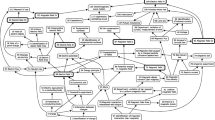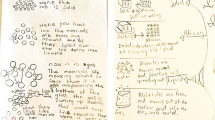Abstract
A characteristic feature of scientific knowledge is the high degree of coherence and connectedness of its conceptual structure. This notion is also behind the widely accepted instructional method of representing the concepts as networks. We suggest here that notions of explanatory coherence and deductive coherence naturally connect the structure of knowledge to the processes which are important in constructing the concept networks. Of these processes, experimental method and modelling are shown to be closely connected with explanatory and deductive coherence, respectively. From this viewpoint, we compare here how experts and novices represent their physics knowledge in the form of concept networks, and show that significant differences between experts’ and novices’ quality of knowledge become directly reflected in the structure of the networks. The results also show how concept networks make visible both the structure of knowledge and the methodological procedures, which support its formation.






Similar content being viewed by others
References
Anderson PW (2001) Science: a ‘dappled world’ or a ‘seamless web’? Stud Hist Philos Mod Phys 32:487–494
BonJour L (1985) The structure of empirical knowledge. Harvard University Press, Cambridge
Bransford JD, Brown AL, Cocking RC (2000) How people learn: brain, mind, experience, and school. National Academy Press, Washington
Chi M, Feltovich P, Glaser R (1981) Categorization and representation of physics problems by experts and novices. Cogn Sci 5:121–152
da Costa LF, Rodrigues FA, Travieso G, Villas Boas PR (2007) Characterization of complex networks: a survey of measurements. Adv Phys 56:167–242
Derbentseva N, Safayeni F, Cañas AJ (2007) Concept maps: experiments on dynamic thinking. J Res Sci Teach 44:448–465
di Sessa A, Sherin BL (1998) What changes in conceptual change? Int J Sci Educ 20:1155–1191
Giere RN (1988) Explaining science: a cognitive approach. University of Chicago Press, Chicago
Giere RN, Bickle J, Mauldin RF (2006) Understanding scientific reasoning, 5th edn. Thomson Wadsworth, Belmont
Haack S (1993) Evidence and inquiry: towards reconstruction in epistemology. Blackwell, Oxford
Harman G (1986) Change in view: principles of reasoning. MIT Press, Cambridge
Hestenes D (1992) Modeling games in the Newtonian World. Am J Phys 60:732–748
Ingeç SK (2008) Analysing concept maps as an assessment tool in teaching physics and comparison with the achievement tests. Int J Sci Educ 67:1–19
Kinchin IM, Hay DB, Adams A (2000) How a qualitative approach to concept map analysis can be used to aid learning by illustrating patterns of conceptual development. Educ Res 42:43–57
Kinchin IM, De-Leij FAAM, Hay DB (2005) The evolution of a collaborative concept mapping activity for undergraduate microbiology students. J Further Higher Educ 29:1–14
Kitcher P (1983) The nature of mathematical knowledge. Oxford University Press, New York
Koponen IT (2007) Models and modelling in physics education: a critical reanalysis of philosophical underpinnings and suggestions for revisions. Sci & Educ 16:751–773
Koponen IT, Mäntylä T (2006) Generative role of experiments in physics and in teaching physics: a suggestion for epistemological reconstruction. Sci & Educ 15:31–54
Kosso P (1992) Reading the book of nature. Cambridge University Press, Cambridge
Kosso P (2009) The large-scale structure of scientific method. Sci & Educ 18:33–42
Lehrer K (1990) Theory of knowledge. Routledge, London
Leve RM (2004) Informational acquisition and cognitive models. Complexity 9:31–37
Machin J, Loxley P (2004) Exploring the use of concept chains to structure teacher trainees’ understanding of science. Int J Sci Educ 26:1445–1475
Mäntylä T, Koponen IT (2007) Understanding the role of measurements in creating physical quantities: a case study of learning to quantify temperature in physics teacher education. Sci & Educ 16:291–311
McClure JR, Sonak B, Hoi K, Suen HK (1999) Concept map assessment of classroom learning: reliability, validity, and logistical practicality. J Res Sci Teach 36:475–492
Mestre JP (2001) Implications of research on learning for the education of prospective science and physics teachers. Phys Educ 36:44–51
Minsky M (1975) A framework for representing knowledge. In: Winston PH (ed) The psychology of vision. McGraw-Hill, New York, pp 211–277
Moreira M (1985) Concept mapping: an alternative strategy for evaluation. Assess Eval Higher Educ 10:159–168
Morrison M, Morgan M (1999) Models as mediating instruments. In: Morgan MS, Morrison M (eds) Models as mediators. Cambridge University Press, Cambridge
Nagel E (1961) The structure of science. Routledge & Kegan, London
Novak J, Gowin BD (1984) Learning how to learn. Cambridge University Press, New York
Pemmaraju S, Skiena S (2006) Computational discrete mathematics combinatorics and graph theory with mathematica. Cambridge University Press, Cambridge
Ruiz-Primo MA, Shavelson RJ (1996) Problems and issues in the use of concept maps in science assessment. J Res Sci Teach 33:569–600
Rumelhart D, Smolensky P, Hinton G, McClelland J (1986) Schemata and sequential thought processes in PDP models. In: McClelland J, Rumelhart D (eds) Parallel distributed processing: explorations in the microstructure of cognition, vol 2. MIT Press, Cambridge, pp 7–57
Ruskeepää H (2004) Mathematica navigator: mathematics, statistics, and graphs, 2nd edn. Elsevier Academic Press, New York
Russell B (1973) Essays in analysis. Allen and Unwin, London
Safayeni F, Derbentseva N, Cañas AJ (2005) A theoretical note on concepts and the need for cyclic concept maps. J Res Sci Teach 42:741–766
Sensevy G, Tiberghien A, Santini J, Laube S, Griggs P (2008) An epistemological approach to modeling: cases studies and implications for science teaching. Sci Educ 92:424–446
Slotte V, Lonka K (1999) Spontaneous concept maps aiding the understanding of scientific concepts. Int J Sci Educ 21:515–531
Snyder JL (2000) An investigation of the knowledge structures of experts, intermediates and novices in physics. Int J Sci Educ 22:979–992
Suppe F (1977) The structure of scientific theories, 2nd edn. University of Illinois Press, Urbana
Thagard P (1988) Computational philosophy of science. The MIT Press, Cambridge
Thagard P (1992) Conceptual revolutions. Princeton University Press, Princeton
Thagard P (2000) Coherence in thought and action. MIT Press, Cambridge
Thagard P (2007) Coherence, truth, and the development of scientific knowledge. Philos Sci 74:28–47
Trowbridge JE, Wandersee JH (1989) Theory-driven graphical organizers. In: Mintzes JJ, Wandersee JH, Novak JD (eds) Teaching science for understanding: a human constructivistic view. Academic Press, San Diego, pp 95–128
van Zele E, Lenaerts J, Wieme W (2004) Improving the usefulness of concept maps as a research tool for science education. Int J Sci Educ 26:1043–1064
Vanides J, Yin Y, Tomita M, Ruiz-Primo MA (2005) Using concept maps in the science classroom. Sci Scope 28:27–31
Wilson EO (1999) Consilience: the unity of knowledge. Vintage Books, New York
Author information
Authors and Affiliations
Corresponding author
Rights and permissions
About this article
Cite this article
Koponen, I.T., Pehkonen, M. Coherent Knowledge Structures of Physics Represented as Concept Networks in Teacher Education. Sci & Educ 19, 259–282 (2010). https://doi.org/10.1007/s11191-009-9200-z
Received:
Accepted:
Published:
Issue Date:
DOI: https://doi.org/10.1007/s11191-009-9200-z




